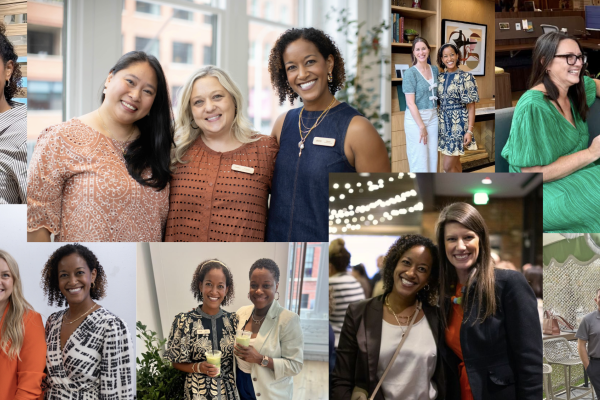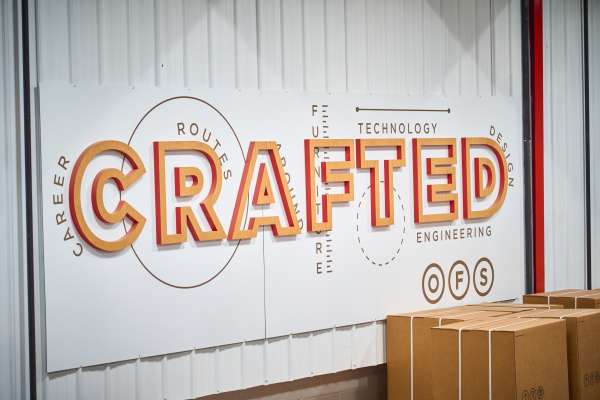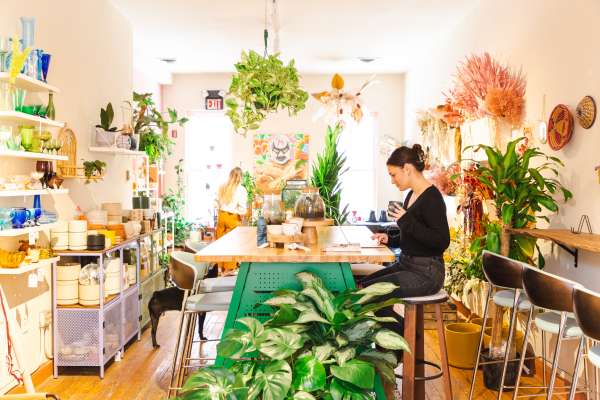A conversation with Lyn Godley
From a conversation with Lyn Godley, owner of Lyn Godley Design Studio and professor at Jefferson University in Philadelphia, Pennsylvania.
A life of making things
Since childhood, Lyn Godley has been a maker—the act of creating has always been a part of who she is. You could even say it’s in her blood. Her grandfather was an inventor with over 90 patents on automotive headlights, and her father was involved in fluorescent lighting early on. For Lyn, the idea that you could have a life composed of making things was not foreign in her family. In fact, it was encouraged.
In the pursuit of artmaking, Lyn attended The Ohio State University’s fine art program and later received her graduate degree in fine art in painting and drawing from the University of Wisconsin in Madison-Wisconsin. “What college did for me was it cemented the discipline of going into a studio every single day when no one’s asking or paying you to,” Lyn explains.
Lyn’s studio practice and artistic exploration has never been about just expressing herself, but rather creating work that people can interact and connect with. “When I finished my schooling I moved to Chicago in my young twenties, and frankly, I didn’t feel like I had much to say creatively,” she recalls. “I just knew I wanted my work to be more than decoration over someone’s couch. Shortly after that, my partner, Lloyd Schwan, and I saw this movement taking place from Italy called the Memphis Group.”
The Memphis Group was founded by Italian designer and architect Ettore Sottsass and became known for its bright-colored, bold furniture designs. “Around this same time, art furniture galleries were starting to open up, so we quickly moved into this field of making things that people would use and started our own company, Godley-Schwan,” Lyn shares.
Following your creative instincts
Godley-Schwan began as a costume jewelry company, and Lyn admits they knew little about running a business. “We had a rep take our products to the New York Gift Fair, and she sold $60,000 worth of stuff,” Lyn said. Godley-Schwan was in business overnight. Following the gift fair, they received a large order from Neiman Marcus—prompting them to pack up and move to New York City.
While Godley-Schwan’s costume jewelry became a means for making a living, Lyn and her partner Lloyd continued to create furniture work for art galleries on the side. “As soon as we moved to New York, the costume jewelry market bottomed out—so we started making tabletop accessories and pulling the furniture we had been creating for art galleries into the Godley-Schwan line,” Lyn notes.
Lyn laughs as she reflects on their business plan, or lack thereof. “Usually, to make money, you design a product and then you keep that product in the line long enough to pay for the research and development, and keep producing and producing it,” she recalls. “We would design a whole new line for every single show we did, simply because that’s what we were interested in doing. The creative act was what was driving us, never the money.”
Though Godley-Schwan may not have had the best business model, over roughly 10 years Lyn and Lloyd designed and sold an impressive portfolio with thousands of creations. Their unique designs gained a following after attending the International Contemporary Furniture Fair (ICFF) and the Salone del Mobile furniture fair in Milan. “We were the only contemporary furniture company from the United States in the show, so we came back with an enormous amount of press coverage,” Lyn notes.
Along with the challenges of growing a business, Lyn and Lloyd were also raising a family. With three young kids at home, they decided to move away from the fast pace of New York City, eventually settling down in Kutztown, Pennsylvania. “Lloyd Schwan was an enormously creative man, but he also struggled with depression, which made running a company and raising kids pretty difficult,” Lyn explains. “A few years after we moved, we decided to separate the company, and I opted to go back to making art.”
As Lyn looked back, she recalled how the entire experience was much grander than she ever imagined—and the success of Godley-Schwan solidified something that she’s since carried with her in other endeavors: permission to follow through with a creative vision, regardless of a practical business plan.
For the love of learning
About a year after leaving New York City, Lyn got a call from Parsons School of Design asking if she would teach a product design course. She agreed and commenced on a new journey, quickly developing a love for teaching.
For the next 15 years, Lyn taught industrial design courses at Parsons, Kutztown University, and eventually, Jefferson University, where she still teaches today. “I think my love for teaching is connected to the same reason I moved away from doing strictly art—which is that I want to do something that has an impact,” Lyn said. “Teaching affords me the opportunity to do that.”
Another element of teaching Lyn has grown fond of is the fast pace of technology change, pushing her to stay on her toes. “Product design today involves so much more technology and science around the environment and social structures,” she comments. “It really forces me to keep learning all the time, which fits my personality well—plus, it’s incredibly humbling to be constantly learning new technology.”
Design today involves more knowledge than any one person can have. Even in her personal work, Lyn requires coding, circuitry science, and the knowledge and help from others. “The longer I teach and the more time I spend in my studio, the more connected the two become,” she explains. For this reason, Lyn runs her classroom like she’s running a design team.
Lyn believes the value of teaching takes on many forms. “At the end of our lives, when we turn around and look to see the wake we are leaving behind us, you have to ask: Did we leave the world a better place than when we got here?”
Whether it’s a teacher passing along what they’ve learned to their students or the other way around—sharing knowledge is the essence of making an impact. It’s through the teacher-student exchange that we build more curious and empathetic humanity.
We're all like moths to a flame
Lyn’s obsession with light first began during the years of Godley-Schwan. “With my grandfather and father involved in the trade, maybe there was just no hope for me to do anything else because no matter what I do, light seems to creep in,” Lyn explains.
Though Lyn had already been working with light for years, it was her solo show in Cologne, Germany, that shifted her work and attitude toward light as a medium. For the show, she used large charcoal images of birds in flight, each threaded with thousands of strands of LED fiber optics. About a week after the show opened, Lyn recalls that she received a rather strange call from the curator. “She rang me to say that people were behaving strangely—they were coming into the gallery and sitting down on the floor, sometimes staying for three hours and coming back multiple times. That’s just not normal in the art world.”
After witnessing the unusual behavior of visitors, Lyn began to wonder if something was occurring on a deeper level than simply observing artwork. She recalls a conversation with friend David McFadden, who was the curator at the Museum of Arts and Design in NYC at the time. “He asked me, ‘Why flowers and birds?’ I didn’t have a clear answer then, other than that it just felt right to me. Now I can say if you’ve read any of E.O. Wilson’s work on biophilia, this idea that we are all genetically linked to natural settings makes perfect sense as to why people were reacting.”
Lyn spent the following year and a half researching types of imagery and light that engage people. “It turned out that not only is nature-based artwork used to relieve stress and evoke calmness, but the wavelength I had used in my pieces was the same wavelength that people use today in light therapy to deal with depression,” she explains.
As Lyn’s understanding of light as a medium grew, she wondered how she could engage with the viewer even more through her artwork. With a desire to learn coding and the ways it can be used to program and alter light, Lyn enrolled in NYU’s telecommunications program—a boot camp that takes a graduate-level course and condenses it into a one-month workshop. “Out of the 200 or so students, there were two of us over the age of 60. It was intense. I was introduced to 37 different programs focused on coding.” Lyn admits she doesn’t remember all of what she learned, but she walked away from the school no longer afraid of coding and ready to integrate technology into her artwork on a more dynamic scale.
To better understand Lyn’s work, it is helpful to understand how dynamic light affects the body not only visually, but physiologically. Recent developments in research have shown that particular wavelengths of light, measured as Spectral Power Distribution (SPD), affect a wide range of our neurobehavioral, neuroendocrine, and Circadian systems. For example, the wavelengths from the sun change throughout the day. In the morning, you will see higher levels of blue; in the late afternoon and evening, higher levels of red, although always containing a range of all wavelengths. However, when you look at the SPD chart of fluorescent light, except for a spike in blue wavelengths, it’s flat—meaning the type of light you are being exposed to has a drastically different effect on the body than that of natural light from the sun. Lyn’s work is designed to replicate or mimic the result of dynamic natural light by using LED technology.
In her studio work, Lyn uses programming to create environments where the user can interact with and benefit from the artwork. “The amount of light coming from one of my pieces is minimal, but if I have a whole wall of work, it begins to increase,” she comments. “So if I can measure the SPD off this work, I can reprogram and code it to match a more optimal SPD for the viewer.”
Today, Lyn is motivated by understanding how research, science, psychology, and artwork can be used together. “How do we use dynamic or interactive art, to lower stress and help in healing?” she says. “I want to know how we can adapt our artwork and environments to have an effect on the people viewing it and have it become a part of their therapy and remedy.”
At Jefferson University, Lyn is working to put together a diverse group of artists, designers, doctors, and scientists to ask a simple question: How do we make artwork for healthcare settings part of a more optimal healthcare experience for patients, visitors, and workers?
Making sense of BIG problems
Never in our history have we faced more global challenges and crises than we do today. The lone genius who once could try to find solutions to these big, complex problems on their own is no longer enough. Untangling the complex issues our world faces today requires a highly diverse team willing to work together.
Driven by this understanding, Lyn and her team of colleagues and students at Jefferson University are doing just that. She comments, “My message to young people is this: It’s far more exciting to have conversations about your work when the dialogue is taking place across multiple disciplines and fields, and you start asking, ‘What is our impact going to be?’”
One of her research partners is the Jefferson Light Research Program, who just completed a six-year study with NASA to evaluate the circadian systems of astronauts. “They are orbiting the earth multiple times a day, so their circadian rhythms are out of whack,” Lyn explains. “The study used SPD to measure their response to different lighting so that the proper type of artificial lighting could be installed in space stations to help astronauts resync their bodies to a natural circadian rhythm.”
Over the course of her working and teaching career, Lyn has come to realize her ability to help people is greatly expanded when she works with other experts around a table. She believes the students coming through her classroom today see this, too. “These kids are growing up in a world where nothing about their footing feels stable; their entire existence seems precarious. So they are much more in tune with the need to make a difference in this world and set things straight. They have zero interest in being the next rockstar designer—their focus is on solving these big problems they have grown up with. I think we’re finally going to have a generation of designers and artists that are doing it for the right reasons.”
The question Lyn and her students at Jefferson University continue to ask is this: Can I be a part of something or make something that moves someone and changes the world for the better?
To each group of students who pass through her class, Lyn raises the challenge: “Think about what drives you, think about what really feeds your soul, and make sure you find time for that. Make a commitment to do it. There are so many reasons not to be in the arts—it’s not always a secure way to make a living. But if it’s your calling, you have to find a way to make it happen.”
As Lyn works with today’s generation of designers and artists, she’s never felt more optimistic. “The young people today are so passionate about making a change, and why not? If our view of the world is a story that we’re making up, why wouldn’t we choose a good one? If I didn’t believe that they would help find a way to get us out of this mess that we’ve made, it would be tough to get up in the morning. So, I apologize to all my students that I’ve just laid the entire burden of the future on them. I expect they’ll be up to the challenge, and I’ll do my best to help them get there.”


















